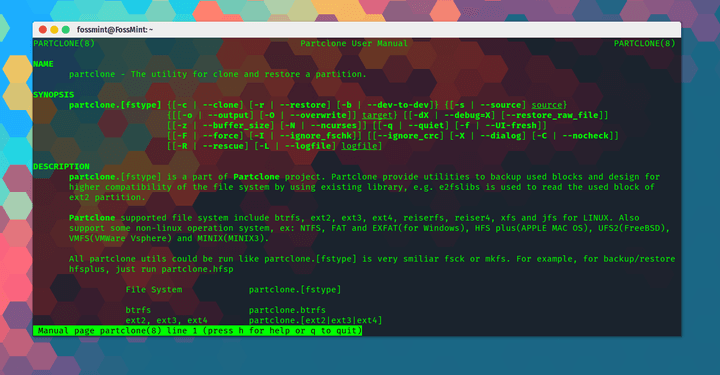mirror of
https://github.com/LCTT/TranslateProject.git
synced 2025-01-19 22:51:41 +08:00
100 lines
3.5 KiB
Markdown
100 lines
3.5 KiB
Markdown
translating---geekpi
|
||
|
||
Partclone – A Versatile Free Software for Partition Imaging and Cloning
|
||
======
|
||
|
||

|
||
|
||
**[Partclone][1]** is a free and open-source tool for creating and cloning partition images brought to you by the developers of **Clonezilla**. In fact, **Partclone** is one of the tools that **Clonezilla** is based on.
|
||
|
||
It provides users with the tools required to backup and restores used partition blocks along with high compatibility with several file systems thanks to its ability to use existing libraries like **e2fslibs** to read and write partitions e.g. **ext2**.
|
||
|
||
Its best stronghold is the variety of formats it supports including ext2, ext3, ext4, hfs+, reiserfs, reiser4, btrfs, vmfs3, vmfs5, xfs, jfs, ufs, ntfs, fat(12/16/32), exfat, f2fs, and nilfs.
|
||
|
||
It also has a plethora of available programs including **partclone.ext2** (ext3 & ext4), partclone.ntfs, partclone.exfat, partclone.hfsp, and partclone.vmfs (v3 and v5), among others.
|
||
|
||
### Features in Partclone
|
||
|
||
* **Freeware:** **Partclone** is free for everyone to download and use.
|
||
* **Open Source:** **Partclone** is released under the GNU GPL license and is open to contribution on [GitHub][2].
|
||
* **Cross-Platform** : Available on Linux, Windows, MAC, ESX file system backup/restore, and FreeBSD.
|
||
* An online [Documentation page][3] from where you can view help docs and track its GitHub issues.
|
||
* An online [user manual][4] for beginners and pros alike.
|
||
* Rescue support.
|
||
* Clone partitions to image files.
|
||
* Restore image files to partitions.
|
||
* Duplicate partitions quickly.
|
||
* Support for raw clone.
|
||
* Displays transfer rate and elapsed time.
|
||
* Supports piping.
|
||
* Support for crc32.
|
||
* Supports vmfs for ESX vmware server and ufs for FreeBSD file system.
|
||
|
||
|
||
|
||
There are a lot more features bundled in **Partclone** and you can see the rest of them [here][5].
|
||
|
||
[__Download Partclone for Linux][6]
|
||
|
||
### How to Install and Use Partclone
|
||
|
||
To install Partclone on Linux.
|
||
```
|
||
$ sudo apt install partclone [On Debian/Ubuntu]
|
||
$ sudo yum install partclone [On CentOS/RHEL/Fedora]
|
||
|
||
```
|
||
|
||
Clone partition to image.
|
||
```
|
||
# partclone.ext4 -d -c -s /dev/sda1 -o sda1.img
|
||
|
||
```
|
||
|
||
Restore image to partition.
|
||
```
|
||
# partclone.ext4 -d -r -s sda1.img -o /dev/sda1
|
||
|
||
```
|
||
|
||
Partition to partition clone.
|
||
```
|
||
# partclone.ext4 -d -b -s /dev/sda1 -o /dev/sdb1
|
||
|
||
```
|
||
|
||
Display image information.
|
||
```
|
||
# partclone.info -s sda1.img
|
||
|
||
```
|
||
|
||
Check image.
|
||
```
|
||
# partclone.chkimg -s sda1.img
|
||
|
||
```
|
||
|
||
Are you a **Partclone** user? I wrote on [**Deepin Clone**][7] just recently and apparently, there are certain tasks Partclone is better at handling. What has been your experience with other backup and restore utility tools?
|
||
|
||
Do share your thoughts and suggestions with us in the comments section below.
|
||
|
||
--------------------------------------------------------------------------------
|
||
|
||
via: https://www.fossmint.com/partclone-linux-backup-clone-tool/
|
||
|
||
作者:[Martins D. Okoi;View All Posts;Peter Beck;Martins Divine Okoi][a]
|
||
译者:[译者ID](https://github.com/译者ID)
|
||
校对:[校对者ID](https://github.com/校对者ID)
|
||
|
||
本文由 [LCTT](https://github.com/LCTT/TranslateProject) 原创编译,[Linux中国](https://linux.cn/) 荣誉推出
|
||
|
||
[a]:
|
||
[1]:https://partclone.org/
|
||
[2]:https://github.com/Thomas-Tsai/partclone
|
||
[3]:https://partclone.org/help/
|
||
[4]:https://partclone.org/usage/
|
||
[5]:https://partclone.org/features/
|
||
[6]:https://partclone.org/download/
|
||
[7]:https://www.fossmint.com/deepin-clone-system-backup-restore-for-deepin-users/
|